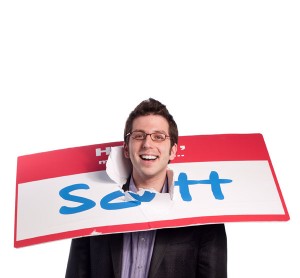Van Wilder said it best: “Write that down.”
Have you ever read someone else’s writing and thought one of the following things:
The answer is: content.
In writing, content is KING. (Duh, right?) But every book, article, report, manual, sermon, speech, poem, even bathroom stall graffiti, has this one thing in common. Content is the stuff good writing is made of. But the one vital step too many writers fail to address is the compulsive collection of content.
Everything you write has the potential to be spicier, funnier, smarter, more interesting and more relevant. And the steps you must take to make this happen are as follows:
1)Open Your Eyes and Ears
2)Write It Down
3)Write It Out
4)Develop Your Own System
In this article, I am going to take you through this process by using one of my favorite pieces of content as an example.
STEP 1: Open Your Eyes and Ears
April 4th, 2004: the anniversary of Martin Luther King’s death, the day my friend Drew ran the St. Louis Marathon, and the day I came to the conclusion that Americans are the most impatient people in the WORLD.
After the race I took Drew out for lunch to celebrate his admirable accomplishment. We finished our meal at Galleria’s The Pasta House and headed out to the parking lot. In the empty spot a few spaces down from my car I saw a tattered, ripped up box. God I detest litter.
‘One sec Drew; I’ll be right back…’
I walked over to take a closer look. A plastic bag that read Kay-Bee Toys slowly brushed up against my jeans like a suburban tumbleweed. On the pavement lay a credit card receipt and discarded instructions for a toy truck.
I picked up the receipt and noted the date and time of purchase: April 4th, 2004. 11:56 AM.
My watch read 1:41 PM.
Unbelievable. The only thing I detest more than litter is impatience.
Okay, that was one of my favorite illustrations that I’ve used in various writings/speeches before. Now, that wasn’t the whole story. And I’m sure based on that incident, I could have used other metaphors or taken a different angle on the trash. But I chose impatience. Because impatience just KILLS me! However, the only reason I’m still able to share that experience is because I followed the first step, which was to Open My Eyes and Ears.
I could have easily hopped into my car and taken Drew home. But I noticed that big, colorful pile of trash, and just HAD to go over there.
Do you ever notice, hear, smell, see or experience things like these? Have people walked by and said phrases that stuck in your head? Good. That means you have a writer’s ear. And next time it happens, don’t walk away. Be curious. Don’t be nosey, but take an interest to the point where you might discover some valuable content.
STEP 2: Write it Down
Then, you MUST capture it. This is part where many writers fail, most likely because they’re not prepared with content capturing tools. If you’re a writer and you don’t keep a pen, paper, notebook, journal, camera, tape recorder or charcoal rubbing sheets with you at all time, you’re missing out on some great content. In fact, I can’t think of a single possession that’s been more valuable to the successful collection of my content than my pen and notepad. It’s leather, about the size of a business card holder, and I don’t go anywhere without it. Ever. And I can whip it out and be ready to write in less than three seconds, not unlike a cowboy’s gun or a guitar player’s pick.
A notepad like this is easy to find at any luggage store. They cost about 15 bucks. Or, if you’re more of a journal person, awesome! But whatever content capturing tool you use, be certain it’s easily accessible in your car, bag, office or on your person at all times – because you never know when inspiration might strike. The whole point is; you don’t want to find yourself saying, ‘If only I would have written that down!’
Now, you don’t need to write down very much. All you need to do is record a few sentences that explain what happened. You’re free to write some details as well, but concentrate more on capturing as opposed to creating. This will come in handy when you look at your notes later. And do it fast. If possible, write it down as soon as something happens. This is why you should always have your capturing tools ready to go. Because not unlike forgetting names, jokes and phone numbers, content is something the mind easily displaces.
STEP 3: Write it Out
Next is the fun part: transferring a valuable story, anecdote, moment, experience, smell, sound or conversation into a useful piece of content. At the end of the day (or week), re-read your notes. If you’re like me and your penmanship looks like a monkey who was trying to write the Hebrew alphabet, this process may take a few minutes. Still, looking back at what you’ve written will bring the experience back to life. And then it’s time to write it down.
Start a new document on computer, or if you prefer ‘the old way,’ grab a blank sheet of paper. Write out that particular piece of content. Look for themes, lessons, bigger pictures, connections and symbols in your experience so it will be a good fit for a book, article or speech.
For example, the story you just read about the discarded toy box was written in one of my seven journals about a year ago. In fact, the exact phrase I just read on the page was:
‘4/4/04 – Toy truck…impatience…lunch at Galleria with Drew.’
To give you an idea of how this process comes full circle:
1)Just now, I browsed through my journal…
2)Saw that story about the trash…
3)And decided to include it in this article.
Wah-lah!
STEP 4: Develop Your Own System
The cool thing about compulsively collecting content is when you start searching for it, and when you start recording it, it will show up EVERYWHERE. Unusual, unexpected, interesting and different writing ideas will magnetize to you!
I started taking this whole ‘content thing’ seriously in 2004. I was working on a new book and I wanted to use a plethora of great stories, illustrations and examples to back up my ideas. So I developed a system. And that’s the last step in this process.
Here’s what I do. It might not work for everyone, but perhaps the structure of such a system will stimulate some ideas for your own. It has several components:
CAPTURING TOOLS
WRITING TOOLS
ORGANIZING TOOLS
All technical designations aside, I think there are two major differences between ‘People who write’ and ‘People who are writers’:
PEOPLE WHO WRITE…Have natural writing skills, creative ideas, excellent grammar, unique style and tone and a passion for the pen.
PEOPLE WHO ARE WRITERS…Have everything from the last paragraph PLUS the awareness to keep their eyes and ears open for great content, the preparation to capture that content, the discipline to transfer that content into writings and the organization to create their own system that turns thoughts into things.
Which one are you?

